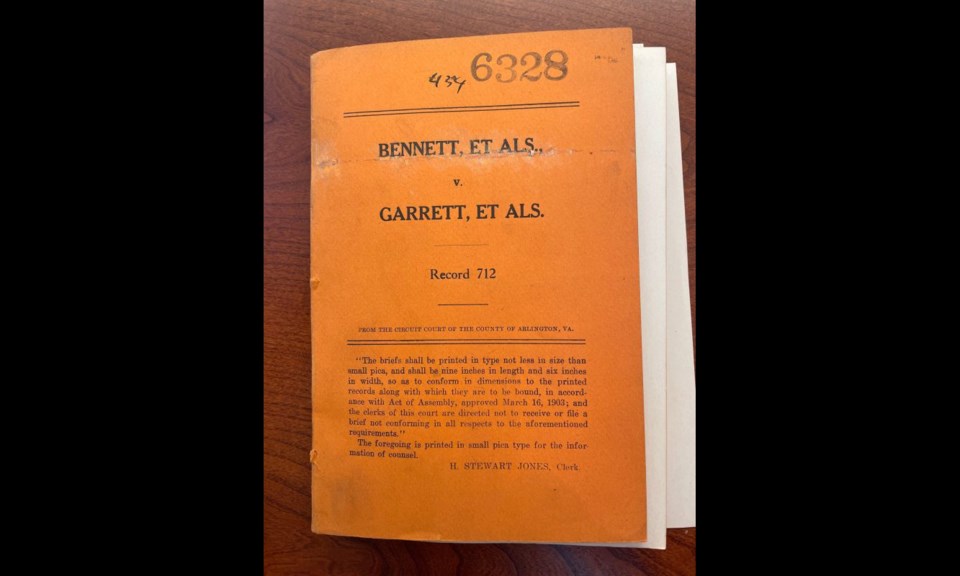Had a court ruling, rendered just over a century ago, gone the other way, Arlington of 2023 could be a hodge-podge of semi-autonomous towns (and their elected leaders) jostling for power against the county government.
Instead, the final ruling in the court case Bennett v. Garrett in 1922 “planted the seeds of the modern county” and ensured Arlington remained a single political entity.
So noted Sean Denniston, a researcher and vice president of the Arlington Historical Society, who offered an update to earlier research on the topic during a July 18 gathering at Central Library.
The matter in question played out in Clarendon – a community whose roots can be traced back to 1900 when former farmland was subdivided into lots sold off at $90 to $140 apiece.
By 1904, the Clarendon Citizens Association had been formed, and by 1920 (with 300 members) was serving as a de-facto local government, handing issues that ranged from zoning and utilities to fire service.
“By 1920, they really did consider themselves a town,” Denniston noted at the forum. “They had been doing their own thing for a long time.”
But the neighborhood lacked a formal charter. And so began the effort to convince judges that just over 700 acres, with a population of about 2,500 including portions of the brand-new community of Lyon Village, should be incorporated into a semi-autonomous town.
Winning the conflict would have given those living there some autonomy from what then was, and for a few more months more would be still, known as “Alexandria County” and was governed by a three-member Board of Supervisors, a vestige of the Reconstruction era.
The battle first was joined at the Circuit Court level in proceedings lasting April 29-May 4, 1920, before Judge Samuel Brent. It was, as transcripts that totaled 400 pages prove, a sometimes blistering event, with accusations and attempts to impugn witnesses hurled back and forth.
(Largely ignored during the court case and broader public discussion, except for times when they were painted in a negative light, were the African-American residents of the county. Restrictive covenants on the original land sales ensured that Clarendon at the time was an all-white community.)
One of the key figures in the battle for incorporation was R.H. Colley, who then headed the Clarendon Citizens Association. Born in 1887, he would live to see a very different community emerge, dying just shy of 102 years old in 1989.
Alexandria County in the first quarter of the 20th century was a sleepy Southern town on its way to becoming a bedroom community for Washington, D.C. Political leadership was vested in a few families and the clique around them, and those in the existing power structure pulled out all the stops to ensure the incorporation effort failed, Denniston said.
When the arguments were done, Judge Brent issued his ruling from the bench, rejecting the request for incorporation. Two years later, the Virginia Supreme Court of Appeals, as it then was known, affirmed his decision, saying Arlington was too compact and homogeneous to be carved into different localities.
Had the ruling gone the other way, today’s Arlington might be a patchwork like Los Angeles County, Calif., where there are nearly 90 independent jurisdictions jostling with the county government.
Had Clarendon won the right to form its own government, “Ballston and Rosslyn would have followed,” Denniston believes.
And that could have changed the trajectory of Arlington in any number of ways. “Who knows what would have happened?” he said.
John Stanton, who serves on the staff of the county library system’s Center for Local History and introduced the speaker, said Denniston is uniquely qualified to bring such stories to life.
“What a thorough, diligent and tireless researcher he is,” Stanton said.
• • •
One side note: Even as the battle to make Clarendon a town was playing out a century ago, Arlington (née Alexandria County) by then already HAD an incorporated town – the town of Potomac, a planned community founded in 1908 consisting of the neighborhoods of Del Ray, St. Elmo, Mt. Ida and Hume in the far southernmost reaches of the county.
In 1930, that swath was annexed by, and incorporated into, the city of Alexandria. Since no Virginia towns can be located within the boundaries of a city, the town of Potomac faded into the history books.
But that, as they say, is another story.



